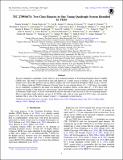TIC 278956474: Two Close Binaries in One Young Quadruple System Identified by TESS
Author(s)
Rowden, Pamela; Borkovits, Tamás; Jenkins, Jon M; Stassun, Keivan G; Twicken, Joseph D; Newton, Elisabeth R; Ziegler, Carl; Hellier, Coel; Soto, Aylin Garcia; Matthews, Elisabeth C; Kolb, Ulrich; Ricker, George R; Vanderspek, Roland; Latham, David W; Seager, S; Winn, Joshua N; Bouma, Luke G; Briceño, César; Charbonneau, David; Fong, William; Glidden, Ana; Guerrero, Natalia M; Law, Nicholas; Mann, Andrew W; Rose, Mark E; Schlieder, Joshua; Tenenbaum, Peter; Ting, Eric B; ... Show more Show less
DownloadPublished version (2.920Mb)
Publisher Policy
Publisher Policy
Article is made available in accordance with the publisher's policy and may be subject to US copyright law. Please refer to the publisher's site for terms of use.
Terms of use
Metadata
Show full item recordAbstract
© 2020. The American Astronomical Society. All rights reserved. We have identified a quadruple system with two close eclipsing binaries in Transiting Exoplanet Survey Satellite (TESS) data. The object is unresolved in Gaia and appears as a single source at parallax 1.08 ± 0.01 mas. Both binaries have observable primary and secondary eclipses and were monitored throughout TESS Cycle 1 (sectors 1-13), falling within the TESS Continuous Viewing Zone. In one eclipsing binary (P = 5.488 days), the smaller star is completely occluded by the larger star during the secondary eclipse; in the other (P = 5.674 days) both eclipses are grazing. Using these data, spectroscopy, speckle photometry, spectral energy distribution analysis, and evolutionary stellar tracks, we have constrained the masses and radii of the four stars in the two eclipsing binaries. The Li i equivalent width indicates an age of 10-50 Myr and, with an outer period of 858+7-5 days, our analysis indicates this is one of the most compact young 2 + 2 quadruple systems known.
Date issued
2020Department
Massachusetts Institute of Technology. Department of Physics; MIT Kavli Institute for Astrophysics and Space Research; Massachusetts Institute of Technology. Department of Earth, Atmospheric, and Planetary Sciences; Massachusetts Institute of Technology. Department of Aeronautics and AstronauticsJournal
Astronomical Journal
Publisher
American Astronomical Society